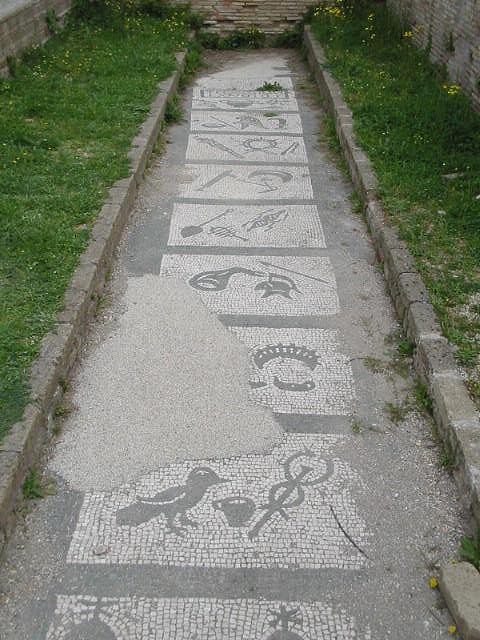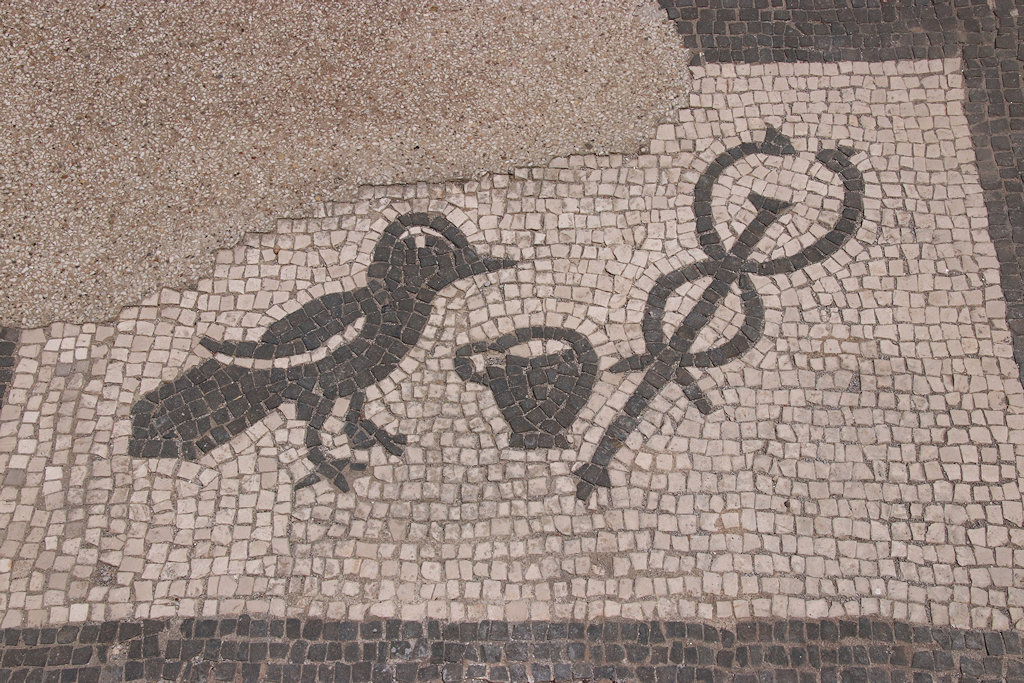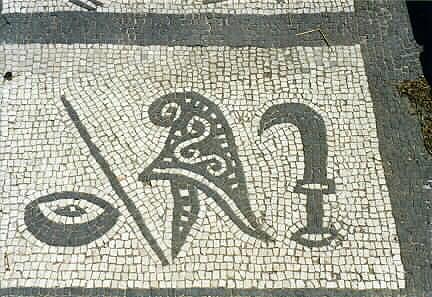|
The Mithraeum of Felicissimus was installed in a building from the second century AD, with modifications dated to the third. The shrine was probably installed in the second half of the third century. At the west end of the latericium south wall is a semicircular wall-niche, starting at 0.70 from the floor, 1.00 wide, and 0.80 deep. A door in the west wall was blocked when the mithraeum was built. In the north wall are three openings, two of which were blocked with vittatum, while the third became the entrance of the mithraeum. Along the side walls are podia, the preserved height of which is 0.20. An altar or niche must have been set against the back wall, but has disappeared. Between the podia, and between the door and the niche is a black-and-white floor mosaic, with depictions in panels created by black bands. Behind the door is a small well (diam. 0.40). It is in a panel with depictions of a krater, symbol of the water, an altar with a burning fire, and two caps with a star, symbols of the Dioscures, who represent the two celestial hemispheres. In the panel near the back wall is an inscription with the name of the person who financed the shrine:
Below the inscription is another krater, flanked by branches, symbols of nature that is flourishing again through the blood of the bull that is killed by Mithras. In the remaining seven panels between the podia are references to the planets and grades of initiation. In the first panel, near the entrance of the shrine, are a caduceus, a reference to the planet Mercurius, and a raven, a reference to the grade corax, who was the herald of the sun. Between the caduceus and the bird is a small vessel. The left part of the second panel has disappeared. A diadem with a moon-crescent is a reference to the planet Venus. Below is a lamp, belonging to the grade nymphus, bridegroom. In the third panel is a helmet, symbol of the planet Mars. Above it is a lance, attribute of the grade miles, soldier. To the left is a bag, another reference to the miles. In the fourth panel is a bolt of lightning, symbol of the planet Jupiter. To the left is an object looking like a spade, but perhaps a simpulum or ladle. It is a reference to the carrying of fire and the grade leo, lion. In the centre is a sistrum, rattle, perhaps a reference to the Magna Mater, who is often seen with lions. In the fifth panel is a moon crescent, symbol of the moon, Luna. Below is Hesperos, the evening star. To the left is a hamatus ensis or falcatus ensis, a sword, the symbol of the grade Perses, Persian. It is usually seen in the hand of Hercules fighting the Hydra and of Perseus killing Medusa (thus creating the Gorgo-head). Perseus was the hero of the Persians. It was a weapon that was characteristic of people in Asia. It can be seen on coins of King Mithridates of Pontus with Perseus, but the weapon only could be depicted too, as symbol of Perseus. Below the star is probably a scythe, also belonging to this grade. It might be a symbol of the rebirth of nature, and of new life. In the sixth panel is a crown with ribbons and seven rays, symbol of the sun, Sol. The grade that is under the protection of Sol is the Heliodromus. To this "Runner of the Sun" refers the object to the right, a whip for the golden and fiery horses. The torch to the left symbolizes Phosphoros, the morning star. In the seventh panel is a pruning knife, attribute of the planet Saturnus. The Phrygian cap to the left belongs to the highest grade, pater, father, the head of the Mithraic community. To the left are a patera and a magical object, a rabdos, an ebony stick, used to promote the initiates to a higher grade. Through the seven planetary spheres, through the seven grades of initiation, the faithful came closer to Mithras and Sol. Some could reach the eighth sphere, of endless light. From literary sources we know that the initiates wore masks and special clothes. |
 Plan of the shrine. North is to the left. SO II, fig. 22. |

The shrine seen from the west. Photo: Klaus Heese.

The shrine seen from the west. Photo: Klaus Heese.

The niche in the west wall, opposite the entrance.
On the floor is a depiction of an altar with a burning fire, two caps with a star, and a krater.
Photo: Klaus Heese.

Detail of the niche.
Photo: Klause Heese.

Detail of the altar in front of the niche.
Photo: Klaus Heese.

Two caps with a star and a krater, near the entrance.
Photo: Klaus Heese.

First panel: raven, small vessel and caduceus.
Photo: Klaus Heese.

Second panel: diadem with moon crescent and lamp.
Photo: Klaus Heese.

Third panel: bag, helmet, and lance.
Photo: Klaus Heese.

Fourth panel: spade, sistrum, and bolt of lightning.
Photo: Klaus Heese.

Fifth panel: sword, moon crescent, Hesperos, and scythe.
Photo: Klaus Heese.

Sixth panel: torch, crown with rays and ribbons, whip.
Photo: Klaus Heese.

Seventh panel: patera, rabdos, Phrygian cap, pruning knife.
Photo: Klaus Heese.

The inscription and a krater flanked by branches.
Photo: Klaus Heese (2024).

The inscription and a krater flanked by branches.
Photo: Wikimedia, Marie-Lan Nguyen (2006).